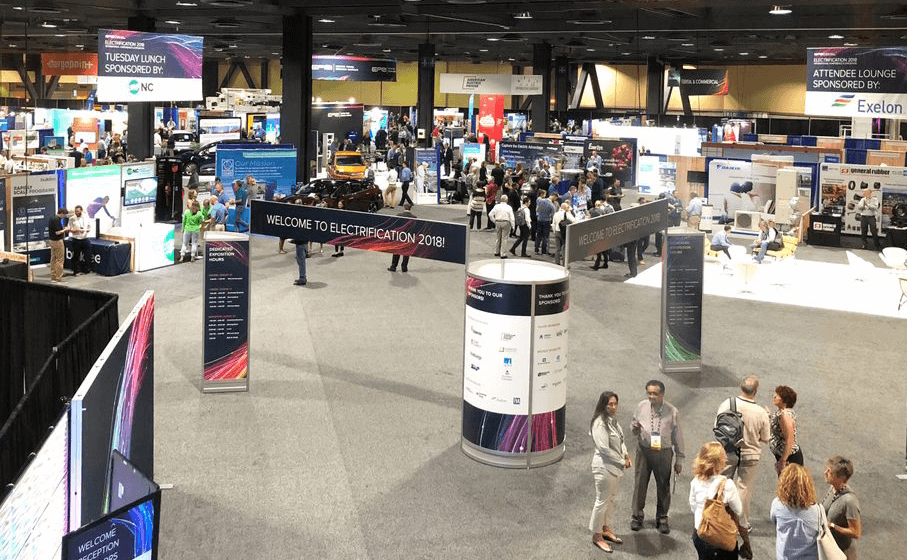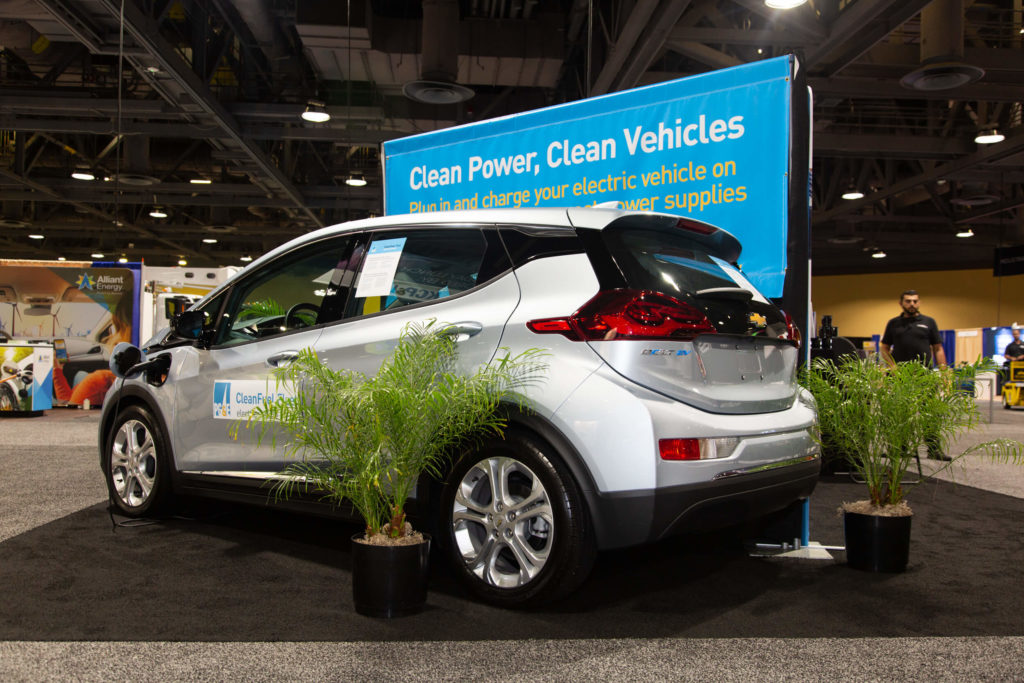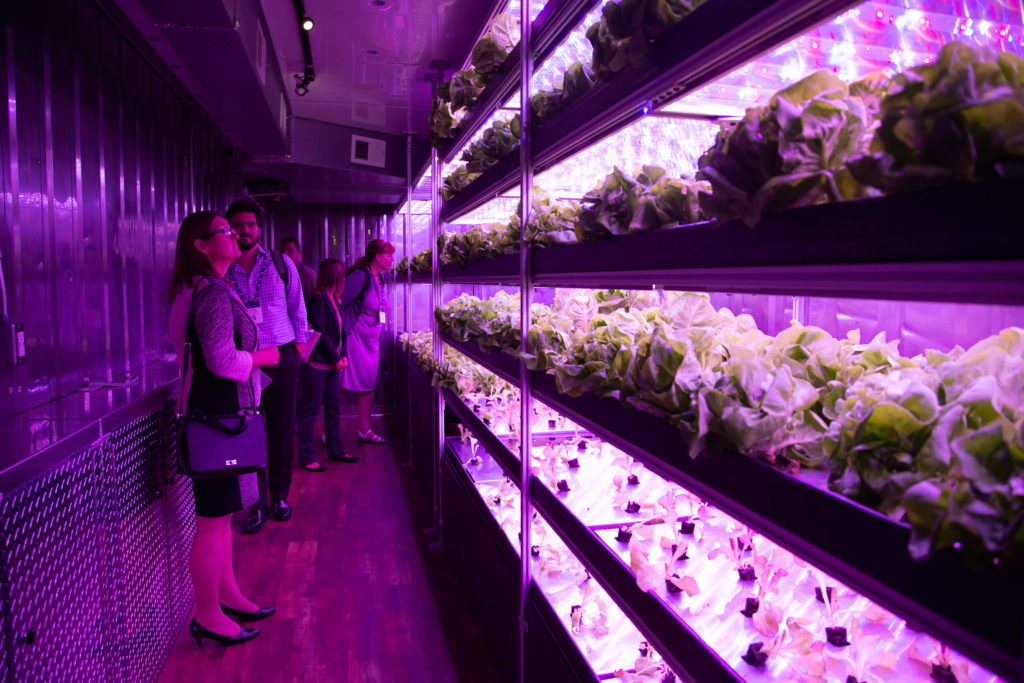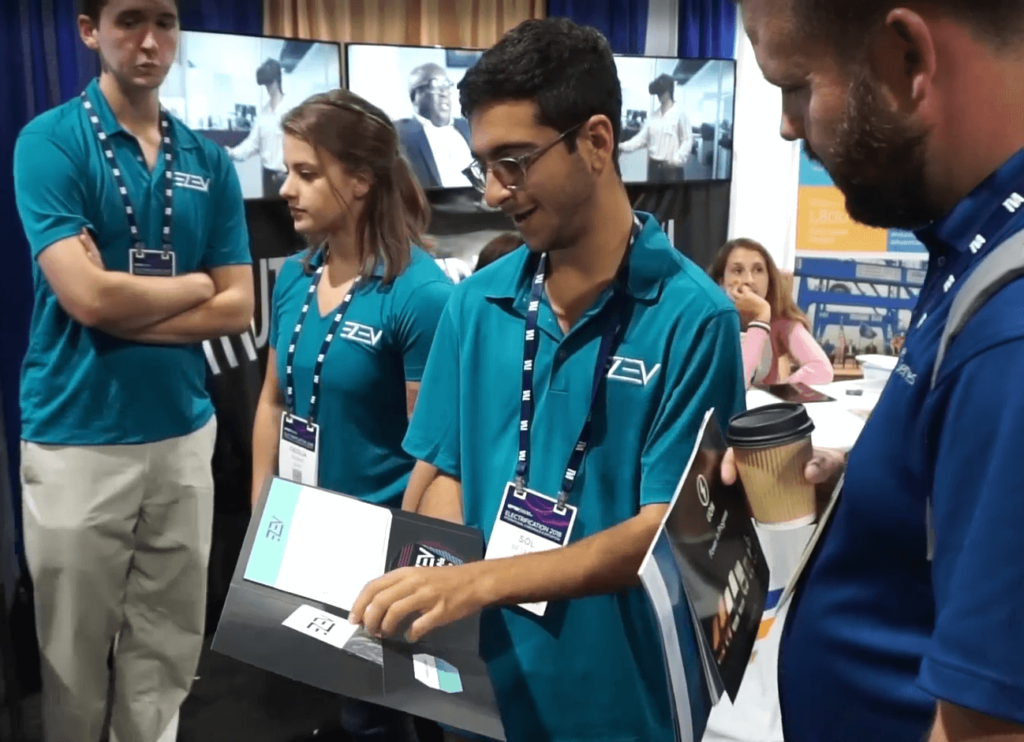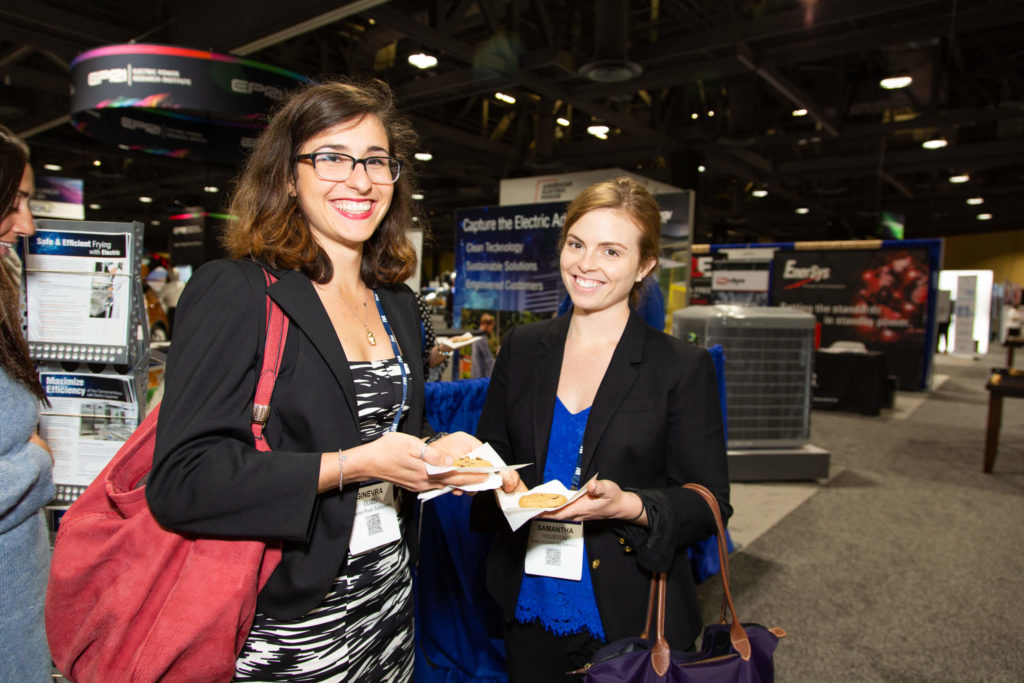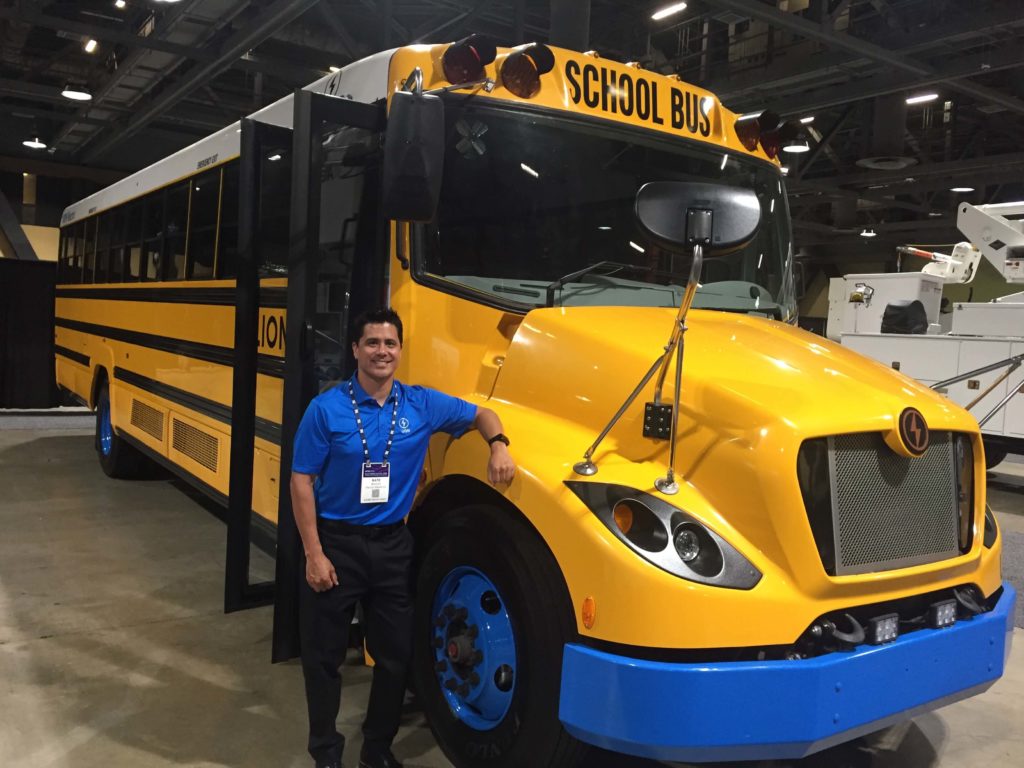At EPRI’s Electrification 2018 conference, FirstEnergy staff baked cookies in their exhibit booth to demonstrate the benefits of an efficient electric convection oven manufactured in Cleveland. With an enticing aroma wafting through the conference hall, attendees could not resist, eating more than 3,000 chocolate chunk, peanut butter, red velvet chocolate chip, and macadamia nut cookies over the three-day expo. “People told us it was the best exhibit booth ‘swag’ ever!” said Randy Frame, FirstEnergy’s director for emerging technologies programs. “And what better way to demonstrate the fast, clean, and uniform baking advantages that electric foodservice equipment has to offer for our customers.”
Enthusiasm for the cookies mirrored the enthusiasm for the event—the first-ever international conference focused on efficient electrification. Many of the 1,830 attendees expressed excitement for electrification and the related opportunities for utilities, their customers, and society. “For decades, electrically-driven end-use equipment has consistently delivered comfort, convenience, and energy savings for our customers,” said Steve Briggs, FirstEnergy advisor for retail innovation technologies. “This conference demonstrated that there are many new electric technologies that are cleaner and more cost-effective—providing even greater benefits for our customers.”
There was a sense that the event was not just a conference, but the beginning of a new chapter for the electric power industry. “This is one of the most exciting times in any industry,” said Paula Gold-Williams, president and CEO of CPS Energy. Expanding on this sentiment in his opening keynote, Edison International President and CEO Pedro Pizarro said, “This is the right time for us to come together and figure out how to respond to this crucial moment in the history of our industry, and of society in general.”
Electrification 2018 packed a lot into four days. FirstEnergy’s electric oven was just one of scores of electric technologies exhibited and discussed at the Long Beach Convention Center. Besides the plenary sessions and exhibit hall, the event included five pre-conference workshops, seven conference tracks, 42 breakout sessions, 225 speakers, 28 sponsors, and 32 additional supporting organizations. Participants discussed technologies, customer adoption, policy and regulatory considerations, grid modernization, environmental benefits, and more.
“The constituency of attendees was unique, exceptionally valuable, and not duplicated anywhere,” said Anda Ray, EPRI senior vice president, external relations and technical resources. “We had utilities, vendors, utility customers, regulators, academia, government, technology providers, associations, media, and more from around the world—all in one place.” Rob Chapman, vice president of EPRI’s Energy and Environment Sector, put it this way: “Electrification is a team sport. It will require utilities, regulators, and other industry stakeholders to collaborate and think differently about how to leverage a cleaner electric supply across all sectors of our economy.”
Electric Transportation: More than Cars
Electric transportation is a rapidly growing industry worldwide. Reflecting on past false starts, General Motors Vice President of Global Strategy Michael Ableson said that he is often asked whether electric cars “are really going to happen this time.” Ableson’s answer for GM is an emphatic “yes.” While a million electric cars will soon be on U.S. roads, the conference showed that electrifying transportation is about much more than cars.
“When an electric school bus pulls up, all you would hear are the squeals of the children inside,” said Nate Baguio, vice president of sales at the Lion Electric Company, which exhibited a conventional electric school bus. Because the vehicle is so quiet, Lion has included in its design speakers under the front grill that play a song to alert children the bus is approaching. “At some schools, the best-behaved child on the bus gets to pick the song of the month,” said Baguio. Drivers can set the bus to pre-cool in the summer and pre-heat in the winter, and children benefit from elimination of toxic diesel fumes.
According to a recent report from a group of environmental organizations, replacing the 480,000 primarily diesel school buses in the United States with electric models would reduce annual greenhouse gas emissions by 5.3 million tons. Electric school buses are in full operation in several states, including California, Massachusetts, and Minnesota.
Buildings as Grid Assets
Buildings offer significant electrification opportunities. Describing a roadmap for building decarbonization at the pre-conference workshop on Building Decarbonization and Electrification, Northeast Energy Efficiency Partnerships (NEEP) Executive Director Susan Coakley emphasized the need to treat buildings as grid assets. “In cold climates like the Northeast, under-insulated buildings can’t hold their heat,” she said. “We need to be aware of that and improve efficiency.” Thermal improvements in the building envelope along with electric heat pumps and other grid-interactive appliances can help utilities manage dynamic building loads more effectively during extreme outdoor temperatures, Coakley added.
NEEP has developed a nine-step plan to accelerate long-term market transformation to efficient electrification in the northeastern United States. Key to this is linking climate stabilization goals with policies and programs that improve the energy performance of existing homes and buildings. The goal is to increase grid flexibility, while saving money, creating jobs, and increasing occupant health, safety, and comfort.
According to NEEP, one electric technology that can support building electrification is the cold-climate air-source heat pump, which can provide high-performance heating at ambient temperatures near or below 5°F along with highly efficient cooling.
Coakley asked attendees: “Would you buy a house—arguably the largest purchase you’ll ever make—without knowing its energy performance?” The U.S. Department of Energy’s Better Buildings initiative has a multi-state effort to provide more transparency through “home energy scores.” According to Coakley, customer surveys have shown that such scores—whether high or low—can increase home sale prices and lease rates. “The transparency is valuable to home buyers and lessees,” she said.
Problem Solving for Industrial Customers
As a complimentary service to its industrial customers, Alabama Power’s Technology Applications Center shares expertise related to various electric technologies, such as infrared heating, induction heating, and powder coating. “Specialists from our Technology Applications Center work closely with our industrial customers to assist in solving problems,” said Cheryl McFarland, the utility’s commercial and industrial sales and technical support manager, during a workshop on lean manufacturing through electrification. “We conduct process and product tests using efficient electric technologies as alternatives to other fuel types.” She described case studies on solutions for weld defects, plaster drying, powder coating, veneer drying, and mop/broom handle production.
In one case study, a material coating company used a natural gas-fired convection oven to cure clear-coat paint in 20 minutes. Alabama Power specialists demonstrated that electric ultraviolet curing could complete the same job in about 7 seconds. By implementing the new system along with an electric infrared dryer, the company increased production, improved product quality, and increased energy efficiency.
The Customer Is King
Some utility customers don’t adopt new technologies that offer clear benefits. Because widespread electrification relies on customer adoption, understanding customer behavior is essential. Dr. Jennifer Weeks, an associate at management consulting firm BEworks, shared an anecdote in which a utility mailed a flyer to its commercial customers offering incentives for efficiency upgrades with significant potential savings. Only 34% took advantage of the offer.
As part of an experiment to better understand this outcome, BEworks mailed one group of customers a postcard describing the upgrades (an “increased accessibility” approach), mailed a second group a formal letter (an “increased credibility” approach), and mailed a control group the original flyer. Relative to the flyer, the postcard had a 50% lower response, while the letter had an 81% higher response. These results indicate that utilities can improve customer participation in their programs using behavioral approaches.
What’s Next for Electrification
In the Tuesday afternoon plenary session, Duke Energy Executive Vice President Doug Esamann announced that his company would host the next EPRI electrification conference in Charlotte, April 6–9, 2020.
“Our vision was to assemble every part of the industry and have a discussion about electrification,” said EPRI CEO Mike Howard. “I think we achieved that. The next step is for us to work collaboratively to help realize the vision.”
“The economy-wide benefits of using electricity to replace fossil fuel end-uses include increased energy efficiency, reduced carbon dioxide emissions, and improved air quality,” said Chapman. “Tapping the opportunities that efficient electrification presents to society and consumers will require increased awareness of these benefits. EPRI looks forward to continuing work with all electric sector stakeholders to support this dialogue through fact-based research.”
Environmental Benefits of Electrification
Electrification’s environmental benefits flow from all customer sectors and many electric technologies. An air quality panel at the conference presented the results of several studies showing the importance of electrification in lowering local emissions and decarbonization. An energy-water nexus session presented various viewpoints on this set of complex interactions.
Edison International President and CEO Pedro Pizarro cited a long list of studies and reports that link electrification and decarbonization, including EPRI’s National Electrification Assessment, Portland General Electric’s vision for meeting Oregon’s environmental goals, National Grid’s 80×50 Pathway, the California Energy Commission’s Decarbonization Strategy, and Edison’s Clean Power and Electrification Pathway. “Everyone is starting to align,” Pizarro observed.
Electrification 2018 Participants: Inspired and Enthusiastic
“Electrification is going to be important to us all, not only today but in the future. This is our opportunity, and being here means being part of the future.”
Michael Kurzeja, Senior Manager, Exelon
“Clearly, our customers are thinking differently. Clearly, many of our regulators are thinking differently. We have to do the same thing.”
Stan Connally, Executive Vice President of Operations, Southern Company
“We need to lean in, try things, iterate, and try again. We need to commit to the idea that if it’s not for all, it’s not for us.”
Gil C. Quiniones, President and CEO, New York Power Authority
Additional Resources:
- Developing a Framework for Integrated Energy Network Planning: Executive Summary
- Electric Vehicle Driving, Charging, and Load Shape Analysis: A Deep Dive Into Where, When, and How Much Salt River Project (SRP) Electric Vehicle Customers Charge
- Electricity Reinventing Agriculture: Insights from EPRI’s Ongoing Research Into Indoor Agriculture
- Quick Insights: Bitcoin Mining, Blockchain, and Electricity Consumption
- Live Recording of the Release of the U.S. National Electrification Assessment
Artwork by Tompert Design

